Anatomical Illustration
1778-1948
Anatomists of this period concentrated on individual organs or organ systems, and new color print technologies made a profound contribution to anatomical instruction in general. Some anatomists, such as Sömmerring and Camper, were able artists and did their own drawings, working as partners and teachers with the engravers. Henry Gray's anatomy handbook, designed to be affordable to students, is the culmination of the illustrated anatomical text.
Between 1860 and 1948, new printing technologies led to even more detailed images, bringing about novelty anatomical teaching materials such as the volvelles of Ralph Segal. Veterinary medicine also made innovative use of newer graphic technologies to raise illustration in their instructional material to a higher level, as can be seen in the books of Schmaltz, Freeman, and Heneaux.
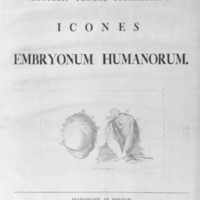
Samuel Thomas von Sömmerring.
Icones Embryonum Humanorum.
Frankfurt: Varrentrapp and Wenner, 1799.
Samuel Thomas von Söemmerring was a polymath similar in intellectual gifts and broad interests to his friend Johann Wolfgang von Goethe. He studied medicine at the University of Göttingen, receiving his degree in 1778.
Using his skills as an illustrator and an acute observer, he developed a classification for the cranial nerves which superseded that of Thomas Willis. He identified and named the twelve cranial nerves and was the first to draw attention to the white matter of the brain, refuting the classification of the spinal cord as another cranial nerve.
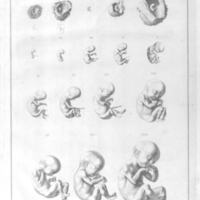
Samuel Thomas von Sömmerring.
Icones Embryonum Humanorum.
Frankfurt: Varrentrapp and Wenner, 1799.
Icones Embryonum Humanorum consists of skillfully engraved plates, each with several depicitions of the human embryo showing development and growth over time. The engraver and artist Kock was personally trained by Sömmerring, who acknowledged him as one of the greatest anatomical illustrators.
Plate I shows the human embryo outside of the uterus from the earliest stages to full term development. Note the appearance of the limb buds in Figure 3.
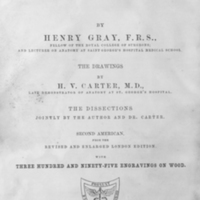
Henry Gray.
Anatomy: Descriptive and Surgical.
Philadelphia: Henry C. Lea, 1866.
Henry Gray was a British anatomist who received his medical degree from St. George's Hospital Medical School in London. In 1853 Gray received an appointment as Lecturer on Anatomy at St. George's and he spent his entire medical career there.
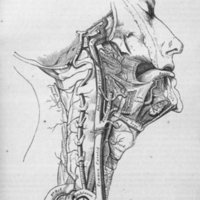
Henry Gray.
Anatomy: Descriptive and Surgical.
Philadelphia: Henry C. Lea, 1866.
Gray's ambition was to produce an inexpensive and comprehensive anatomy textbook for medical students. The first British edition of Gray's Anatomy: Descriptive and Surgical Theory was published in 1858. Henry Vandyke Carter, a highly skilled illustrator and meticulous anatomist, made the drawings from which the published engravings were executed.
Gray died from smallpox in 1861, and subsequent editions were revised by other anatomists. The first five American editions were edited by Richard James Dunglison. The 40th edition of Gray's Anatomy was published in 2009 with over 1550 pages. The American editions—the 2nd edition is shown here—were used in the anatomy classes of almost every American medical school. The University of Missouri was no exception.
Figure 212 shows a detailed illustration of the internal and vertebral arteries of the head and neck.
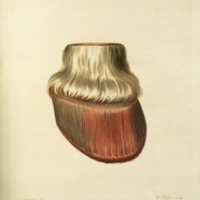
Horses and mules provided much of the power and transportation for commerce, industry, and warfare before the twentieth century, and, therefore, the care and treatment of draft and riding animals was of the utmost importance. Medical care and the maintenance of horses and mules generated much research and publishing in equine anatomy during the eighteenth century.
A sporting gentleman and plantation owner, Strickland Freeman wrote some early works on riding as well as the veterinary aspects of horsemanship and botany. As an advocate of modern and scientific farming and animal husbandry, he introduced progressive practices to the agricultural tenants of his Buckinghamshire estates.
Freeman's most important anatomical work, Observations on the Mechanism of the Horse's Foot, was on horse-shoeing practices and methods. Plate 13 shows the front view of the internal anatomy of a horse's hoof. The engraving is finely detailed and hand-tinted. Freeman descibed the illustration as "showing that the true skin has a fibrous laminated structure, from the coronet to the extremity of the toe.."
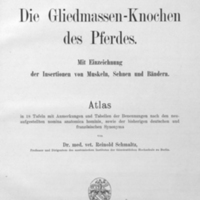
Reinold Schmaltz.
Die Gliedmassen-Knochen Des Pferdes.
Berlin: Richard Schoetz, 1898.
Reinhold Schmaltz was born in Prussia. Studying in Hanover he qualified as a veterinary surgeon in 1884. Schmaltz was appointed an anatomical demonstrator (prosector) at the Anatomical Institute in Berlin in 1886, becoming an Institute Director in 1889. While he authored many specialized anatomical studies on domestic animals, he is perhaps best remembered for his five-part Atlas of the Anatomy of the Horse. The book, Die Gliedmassen-Knochen des Pferdes, is a part of this larger work.
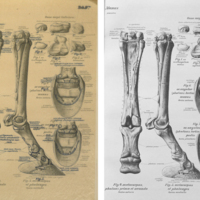
Reinold Schmaltz.
Die Gliedmassen-Knochen Des Pferdes.
Berlin: Richard Schoetz, 1898.
Die Gliedmassen-Knochen des Pferdes contains excellent illustrations of the bones of the legs of the horse. An unusual aspect of this work is the translucent paper overlays for each illustration. These overlays allow the bones to be studied on the main illustration. The relation of the tendons and ligaments to the underlying bones can then be examined when the overlay page is moved into place.
Figure 4 contains two skeletal figures with an overlay for the attachment points of the tendons and ligaments to bones of the horse's foreleg.
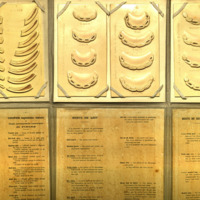
A. Héneaux.
Caractères De L'Age: Chevaux & Mulets....
Marquette-Lez-Lille: n.p., n.d.
This table or wall chart of the dentations of horses and mules has text that was compiled by the French National College of Veterinarians. It contains drawn illustrations of the teeth of horses and mules on one side with a series of plastic casts of the crowns of the teeth on the other. The casts are arranged in order of age, from young to old. Each placard of casts is accompanied with simple instructions on evaluating and identifying equine teeth.
The purpose of this practical reference work was to provide an easy-to-use reference for purchasing agents of the French Army, so that they could judge the age and the fitness of horses or mules. In the front inside cover of the book is a printed statement of ownership for a specific cavalry troop.
Potential frauds in purchasing horses and mules are described in the text. Unethical practices included filling teeth with cement when crowns had worn down to the dentin or filing teeth to make the animals appear more youthful.

Volvelles, or graphic wheels, are devices consisting of a series of movable discs that collate a large amount of information into a compact delivery device. The contents of Bodyscope-shown here in its fourth edition-are presented on four, pierced card sleeves, with a turning disc inside. Each of the four "pages" has three pierced sections containing five subjects on the rotating disc beneath. Each page focuses on a different physiological area and includes both descriptive and explanatory passages for each organ system.
Above each illustrated human figure is an epigram written by Ralph Segal, relating not to science, but to culture and society. For example, the epigram above the female figure reads:
Volvelles like Bodyscope were popular from the 1930s to the 1960s.